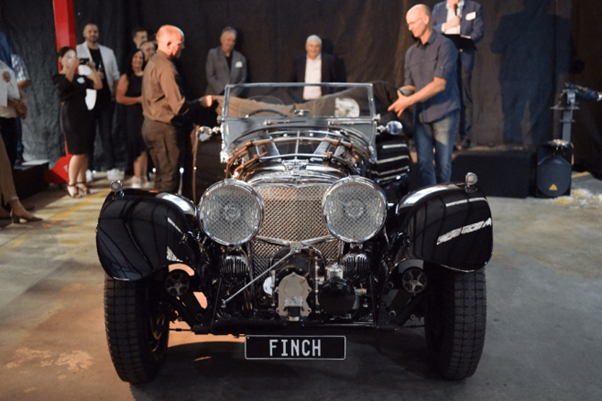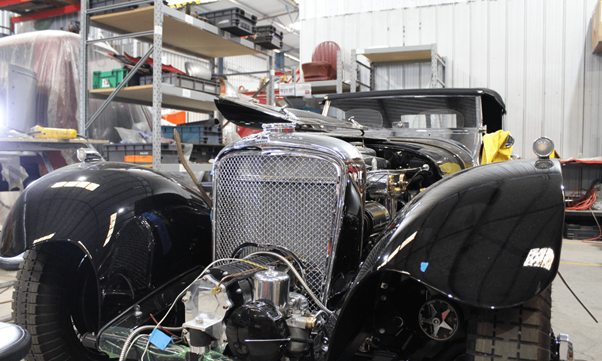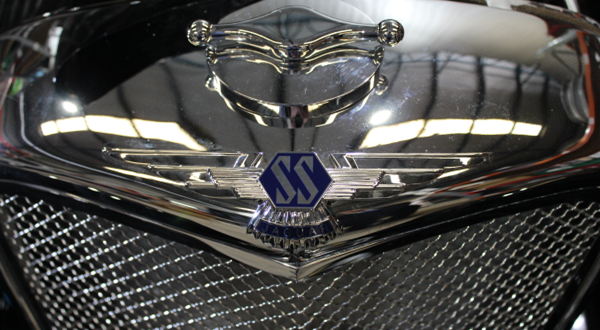An Adelaide Hills-based car restoration firm is preparing to ship an accurate reproduction of a classic 1930s sportscar, using modern technology to ensure authenticity to the millimetre.

Finch Restorations unveiled its authentic reproduction of a 1938 SS Jaguar 100. Photo: Finch Restorations.
With a price tag believed to be in the “high six-figure range”, Australia’s oldest car restoration company Finch Restorations unveiled its reproduction of a 1938 SS Jaguar 100.
Built for a client in Tampa, Florida, the Jaguar is an example of ongoing auto manufacturing in the state. Though high-volume South Australian car making may have ceased in 2017 with the closure of Holden’s factory, Finch proves high-value automaking is still happening.
At an invite-only soiree at Finch’s Mt Barker workshop, the firm unveiled its Jaguar reproduction which was made using the same materials as the original but achieved using high-tech innovations like 3D scanning.
The team, helmed by Finch’s current proprietor Peter Roberts, drew on 1938 drawings and specifications to reproduce the classic car.
A couple of modern modifications are present to satisfy the discerning buyer in Florida: the legroom has been extended as the soon-to-be owner of the Jaguar is 6’4 tall, and a Wade RO34 supercharger not present in the original model was added to give the engine some extra oomph. There’s also a modern fuel cell in the tank to improve the safety of the vehicle.

The Wade RO34 supercharger is a more ‘modern’ addition to the SS Jaguar 100. Photo: David Simmons
Roberts, a former shipbuilder said the team was thrilled to show off the black beauty, which has a retractable cabin and a glossy finish.
“It’s a huge amount of effort for us to build a car from scratch,” Roberts said, adding there were likely “thousands” of man-hours put into the car, on top of the more than 55 years of experience built-up at the Hills-based business.
It was built by hand too, with Finch one of the only garages in the world with the know-how to construct a car of this kind owing to the complexity of the build and the knowledge lost when automaking was supercharged by industrial-scale technologies.
In saying that, he’s hoping to get more orders in for the SS Jaguar 100 model as – like in shipbuilding – “it always takes longer [to build] the first one”.
“We would probably like to build between three and five concurrently so that you can build three to five chassis in one go,” he said.
It’s not the first time that Finch has reproduced a car like this – the company’s founder Ray Finch built his reputation on the process – but the re-tooling and upgrading of the company’s process to create the car is new for the business.
Central to this was one of the company’s employees, Andrea Manclús Clemente, who last year was named the 2023 “emerging innovator” at the Women in Innovation Awards.
The designer and scanner technician used 3D laser scanning to ensure to-the-millimetre precise measurements for the reproduction. It’s not an exact science though, considering vehicles from the 1930s rolled out to market with their own unique quirks.
“This has been a ground-breaking thing that we’ve been doing here,” Roberts said.
“We scanned the original body cars and looked at other examples and compared them – these old 1930s vehicles are all handmade, they don’t come out of a press, they all are different.
“So you’re trying to look at the best average.”
The process was made even more difficult by the fact that the SS Jaguar 100 had a very limited run.
The company that made them at the time – S.S. Cars (Swallow Sidecar Company) – built the Jaguar as a line of vehicles. The ‘100’ in the name stands for how fast it could go (100 miles per hour).
Since World War II and the Nazi regime corresponded with the SS Jaguar 100’s lifespan, the English firm ditched the ‘S.S.’ from its title.

Finch’s reproduction is detail-perfect, even down to the now-defunct old name for the original manufacturer. Photo: David Simmons.
Jaguar went on to build the XK120 after the SS 100 post WWII which was the fastest car in the world at the time.
But Roberts said “a lot of people regard the SS 100 as the quintessential, most beautiful sportscar of its time”.
They also picked yesterday – a leap day – to unveil the car because the Jaguar bonnet mascot is called “the leaper”.
“The first factory Jaguar leaper was actually put on an SS 100 that went to Prince Michael of Romania, and the first ever photograph of a Jaguar leaper was on an SS 100,” Roberts said.
The brand-new classic car was on display at the All British Day at Echunga on Sunday 3 March, and at Finch’s stand at the Adelaide Motorsport Festival the following weekend.
After that, the car was loaded up and shipped to Florida to be enjoyed by its enthusiastic new owner.
Roberts also hinted at plans for Finch’s soon-to-be-opened showroom at Hindmarsh, bringing the Finch experience closer to the CBD. News on that front is expected very soon.



